Driverless Cars in San Francisco: Are They Ready to Take Passengers?
This fall, Waymo opened their driverless-car doors to the San Francisco public a year after removing human safety drivers from behind the wheel, prompting both…
This fall, Waymo opened their driverless-car doors to the San Francisco public a year after removing human safety drivers from behind the wheel, prompting both civilians and city officials to think critically about the safety of these vehicles.
Initially under the name of the Google Self-Driving Car Project, the quest for uninterrupted autonomous mileage was born in 2009. Eight years later, Waymo first took to the streets, beginning in Phoenix, Arizona. Since 2017, San Franciscans have watched as these strange, bulky vehicles were introduced to the city streets, gradually becoming a daily sighting. Steadily, Bay Area residents grew accustomed to their presence, however foreign and dystopian the new vehicles appeared. For many years, there had been a human safety driver at the wheel who quelled anxieties surrounding an increasingly automated world. That changed in the summer of 2022 when Waymo started testing the vehicles without their human safety drivers.
It was a strange site. Drivers and pedestrians alike looked through Waymo windows and into an empty vehicle—the steering wheel spinning, but without hands to direct it. During this adjustment period, San Franciscans found themselves channeling their road rage at nobody at all, and there was plenty of cause for the overwhelming frustration.

The vehicles have been known to sneak up on anxious parallel parkers, blocking parking spots, and standing their ground until the detected “obstacle” has moved. Pedestrians could be seen dancing on and off curbs, tangoing with the robot’s sensors, and visibly considering whether they are about to get hit by a robotaxi. Its introduction to the city was a rocky start, to say the least. These inconveniences have raised questions about whether these cars are really ready to be on the road and have the ability to respond to the nuances of city driving. Now, with paying passengers in the back seat, the question of safety looms even larger.
Upon opening the Waymo app, Waymo One, you are greeted with the slogan: “The world’s most experienced driver”. However, the robotaxi has garnered quite a bit of media attention that would suggest the opposite. In June of 2023, there was a mass shooting in San Francisco’s Mission District in which seven people were injured. While emergency vehicles rushed to the scene, a Waymo taxi, having detected unusual activity, parked in the middle of the road and blocked EMT access to the scene. Just in August, a Waymo vehicle collided with a firetruck, further raising concerns about how these self-driving vehicles interact with first responders. A San Francisco supervisor, Aaron Peskin commented on the situation: “They should take a time-out and a pause until they’ve perfected this technology in a way where people don’t end up burning to death or getting injured.”
Waymo’s website outlines the specific measures taken to ensure passenger and pedestrian safety. The vehicles work through a combination of high-tech sensors and cameras, which means each robotaxi costs roughly $200,000. If a vehicle does encounter a problem, there is a roadside assistance team ready to be deployed from a Waymo site.
While there is a palpable air of concern surrounding the new taxi service, San Franciscans can’t help but be intrigued by this new technology. The app seems to have taken off, despite the city’s reservations. If you are looking to take a trip in a Waymo taxi, expect to be on the waitlist for a couple of months. With fare prices rivaling that of Uber and Lyft, are driverless cars the future of travel?
Disclaimer: The views, opinions and positions expressed by the authors and those providing comments, opinions on this website are theirs alone, and do not necessarily reflect the views, opinions or positions of M-Lifestyle and their affiliates. M-Lifestyle does not claim ownership of any images used, unless otherwise specified.
![]()






